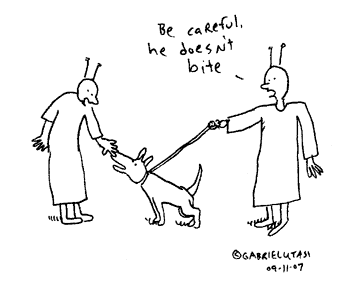
Did you know that there are approximately 74.8 million dogs in the USA and that according to the ASPCA's web page on dog bite prevention, roughly HALF of all children in the United States will be bitten by a dog before their 12th birthday? In fact, a survey by the national Centers for Disease Control and Prevention in Atlanta ("CDC") concluded that dogs bite nearly 2% of the U.S. population - more than 4.7 million people annually, and almost 800,000 bites a year are severe enough to require medical treatment.
In addition to the trauma and medical costs, dog bites often result in law suits and even, in some cases, with the dog having to be put down.
These are scary facts but there are things that people can do to reduce the risk of dog bites.
Most children are bitten by a dog known to them - a family pet or friend's dog is implicated in about 77% of cases - and the bite is often as result of the child not understanding appropriate ways to behave around dogs.
How kids should behave around dogs to reduce risk of being bitten -
The ASPCA advises parents to do an activity with their child where they pledge the following:
- I will not stare into a dog's eyes.
- I will not tease dogs behind fences.
- I will not go near dogs chained up in yards.
- I will not touch a dog I see loose (off-leash) outside.
- If I see a loose dog, I will tell an adult immediately.
- I will not run and scream if a loose dog comes near me.
- I will stand very still (like a tree), and will be very quiet if a dog comes near me.
- I will not touch or play with a dog while he or she is eating.
- I will not touch a dog when he or she is sleeping.
- I will only pet a dog if I have received permission from the dog's owner.
- Then I will ask permission of the dog by letting him sniff my closed hand.
Download this handy activity sheet to walk through with your child to help them understand the difference between safe and potentially dangerous interactions with dogs.
What pet owners can do to reduce the risk of their dogs biting others -Doglaw.Hugpug.com is a handy online dog law info center that has the following advice to reduce potential liability resulting from dog bites:
- Train and socialize your dog. Exposure to lots of people and situations at a young age is crucial. For some good tips, contact the Humane Society of the United States at www.hsus.org or the American Dog Trainers Network at www.canine.org.
- Never let a dog run at large. In some states, you're automatically liable for any injury your dog causes while at large.
- Watch your dog around children. Young children, who may unknowingly provoke a dog, are especially likely to be bitten - even by dogs they're familiar with. Never leave a dog alone with a toddler or infant. Make sure the gate to your yard is child-proof.
- Keep your dog's vaccinations current. If your dog bites someone the authorities, not to mention the victim, will view it a lot more seriously if the dog doesn't have a current rabies vaccination.
- Keep the dog out of strangers' paths. Lots of people - mail carriers, salespeople, poll-takers, Girl Scouts - routinely come to your front door; keep the dog away from it. A fenced front yard isn't good enough; most people will open a gate and walk on up to the door.
- Post warning signs. If you have any reason to think that your dog might injure someone coming onto your property, post "Beware of Dog" or "Dog in Yard" signs prominently. Stay away from creative variations on the traditional signs; someone could reasonably assume that a cartoon-like "Trespassers Will Be Eaten" sign is a joke, not a serious warning.
Dog owners can read more on dog-specific law in this book called Every Dog's Legal Guide, a must-have book for your owner.
A little education and responsibility can go a long way to preventing dog bites and reducing trauma all round - we wish you a dog-bite free future!








No comments:
Post a Comment